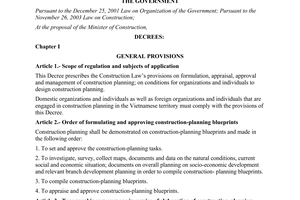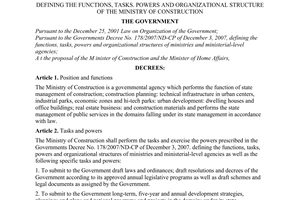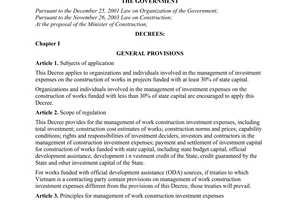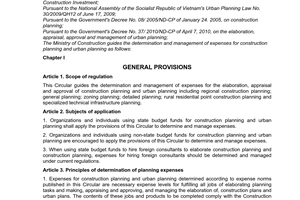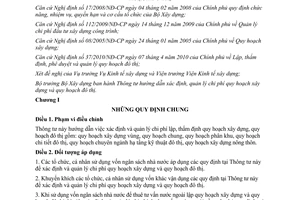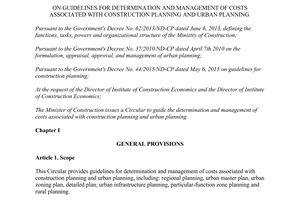Circular No. 01/2013/TT-BXD guiding the calculation and management of expenditur đã được thay thế bởi Circular 05/2017/TT-BXD guidelines management costs associated construction urban planning và được áp dụng kể từ ngày 01/06/2017.
Nội dung toàn văn Circular No. 01/2013/TT-BXD guiding the calculation and management of expenditur
|
THE MINISTRY OF CONSTRUCTION |
SOCIALIST
REPUBLIC OF VIETNAM |
|
No. 01/2013/TT-BXD |
Hanoi, February 08th 2013 |
CIRCULAR
GUIDING THE CALCULATION AND MANAGEMENT OF EXPENDITURES ON CONSTRUCTION PLANNING AND URBAN PLANNING
Pursuant to the Government's Decree No. 17/2008/ND-CP dated February 04th 2008, defining the functions, tasks, powers and organizational structure of the Ministry of Construction;
Pursuant to the Government's Decree No. 112/2009/ND-CP dated December 14th 2009 on the management of construction expenditure;
Pursuant to the Government's Decree No. 08/2005/ND-CP dated January 24th 2005 on construction planning;
Pursuant to the Government's Decree No. 37/2010/ND-CP dated April 07th 2010 on the formulation, appraisal, approval, and management of urban planning;
At the request of the Director of Department of Construction Economics and the Director of Institute of Construction Economics;
The Minister of Construction issues a Circular to guide the calculation and management of expenditures on construction planning and urban planning.
Chapter I
GENERAL REGULATIONS
Article 1. Scope of regulation
This Circular guides the calculation and management of the expenditures on formulating, appraising construction planning and urban planning, including regional construction planning, general planning, zoning, detailed urban planning; urban technical infrastructure planning, rural construction planning.
Article 2. Subjects of application
1. The organizations and individuals funded by the State budget shall apply this Circular to the calculation and management of expenditures on construction planning and urban planning
2. The organizations and individuals fund by other sources are recommended to apply this Circular to the calculation and management of expenditures on construction planning and urban planning.
3. When using the State budget to hire foreign experts to give advice on construction planning and urban planning, the calculation and management of the expenditure on hiring foreign experts must comply with Article 7 of this Circular and other current relevant regulations.
Article 3. Rules of expenditure calculation and management
1. The expenditures on works according to the limits prescribed in this Circular are already inclusive of expenditure on collecting relevant documents; expenditure on stationery, expenditure on hiring experts; expenditure on depreciation; expenditure on management; expenditure on seeking opinions; expenditure on convention for approving planning project result; expenditure on training (provided for consultancy units); insurance (social insurance, health insurance, unemployment insurance, professional liability insurance), and pre-calculated taxable income, but exclusive of VAT. VAT shall be added when making the estimate of the planning project as prescribed by current regulations.
2. Estimates shall be made to calculate the expenditure of construction planning and urban planning works without limits.
3. If the scale of the planning project lies between the two scales prescribed in this Circular, the expenditure limits shall be calculated by interpolation. The planning projects of which the scales are greater than that prescribed I this Circular, the expenditure on making planning projects shall be determined in the estimates.
4. If this Circular is not suitable for calculating the expenditure on the special construction planning and urban planning works, the expenditure shall be determined in estimates.
Chapter II
CALCULATION OF EXPENDITURES ON MAKING CONSTRUCTION PLANNING AND URBAN PLANNING
Article 4. Calculating expenditure on making planning projects
1. Calculating expenditure on making construction planning project
a) The expenditure on making regional construction equals the expenditure limits in Table 1 (in the enclosed Annex), multiplied by the area.
b) The expenditure on making construction planning projects for rural residential areas:
- The expenditure on orienting the development of the rural residential neighborhood network and technical infrastructure in communes equal the expenditure limits in Table 2 (in the enclosed Annex), multiplied by the anticipated population over the planning period in the approved planning objective (or adjusted planning objectives).
- The expenditure on making general planning for architectural space and technical infrastructure of the commune centers and each residential neighborhoods in the commune equals the expenditure limits in Table 3 (in the enclosed Annex) multiplied by the planning area.
c) The expenditure on making general construction planning for special complexes (hi-tech zones, economic zones, resorts, industrial parks, and urban areas that have special functions) equals the expenditure limits in Table 4 (in the enclosed Annex), multiplied by the planning area.
d) The expenditure on making detailed construction planning for special complexes (hi-tech zones, economic zones, resorts, industrial parks, and urban areas that have special functions) equals the expenditure limits in Table 5 and Table 6 (in the enclosed Annex), multiplied by the planning area.
dd) The expenditure on making detailed planning for industrial parks equals the expenditure limits in Table 7 (in the enclosed Annex), multiplied by the planning area.
2. Calculating expenditure on making urban planning projects:
a) The expenditure on making general urban planning equals the expenditure limits in Table 8 (in the enclosed Annex) multiplied by the anticipated population in the planning period of the approved planning objectives (or adjusted planning objectives), not to mention the anticipated population according to the orientation).
b) The expenditure on making detailed urban zoning equals the expenditure limits in Table 9 (in the enclosed Annex), multiplied by the zoning area.
c) The expenditure on making detailed urban planning equals the expenditure limits in Table 10 (in the enclosed Annex), multiplied by the planning area.
d) The expenditure on specialized technical infrastructure planning of central-affiliated cities is the percentage in Table 11 (in the enclosed Annex) of the expenditure on making the corresponding general urban planning.
3. The expenditures on making the following planning projects are determined by making estimates:
a) Planning adjustment: the expenditure on planning adjustment shall be determined by making estimates based on the works, the scale, range, and extent of adjustment of the planning project.
Where comprehensive adjustment is necessary but the range of adjustment does not exceed the area and population of the approved planning, the expenditure on adjusting regional construction planning, general urban planning, and detailed urban planning must not exceed 70% of the expenditure on making the new corresponding planning; the expenditure on urban zoning must not exceed 50% of the expenditure on making a new corresponding planning.
If the range of adjustment exceeds the area and population of the approved planning, estimates shall be made for calculating adjustment expenditure.
If the comprehensive adjustment of planning project is complicated, the area and population exceed 30% of the approved scale, the adjustment expenditure in calculated similarly to the expenditure of a new planning project.
b) Making a separate urban design projects: the expenditure on making separate urban design projects must not exceed the limited expenditures on detailed urban planning on the scale of 1/500.
c) Making interregional, inter-provincial, inter-city specialized planning for technical infrastructure
d) Other construction planning and urban planning projects
4. The content of the estimates of the expenditure on making planning projects that must be calculated by making estimates is guided Part II of the Annex enclosed with this Circular. The estimate must be based on the planning objectives approved by competent authorities.
Article 5. Determining expenditures on establishing objectives, approving planning projects, managing the making of planning projects, and some other works
1. The expenditure on establishing planning objectives is calculated based on the percentage of the expenditure on making the corresponding planning project, specified in Table 12 (in the enclosed Annex).
2. The expenditure on appraising planning objectives equals 20% of the expenditure on establishing planning objectives.
3. The expenditure on appraising planning projects is calculated according to the percentage of the expenditure on making planning projects, specified in Table 12 (in the enclosed Annex). When opinions from State management agencies on the planning project is necessary, the expenditure on seeking opinions is extracted from the expenditure on appraising the planning project, equal to 20% of the expenditure on appraising the planning project.
4. The expenditure on the making of planning projects is calculated based on the percentage of the expenditure on making planning projects, specified in Table 12 (in the enclosed Annex). The expenditure on managing the formulation of local, interregional, or nationwide construction planning projects, and special urban planning projects, is calculated based on the limits, and adjusted with coefficient K = 2.
5. If the opinions from the community on the planning project is necessary, the expenditure on seeking opinions shall be determined by making estimates, but it must not exceed 2% of the expenditure on making the corresponding planning project.
6. The expenditure on announcing a planning project determined by making estimates, but it must not exceed 3% of the expenditure on making the corresponding planning project.
7. The expenditure on making the planning model is calculated based on the expenditure limits in Table 13 (in the enclosed Annex) multiplied by the area of each planning model.
Article 6. Other relevant expenditures
1. The expenditure on making a planning project according to the limits in this Circular does not include the expenditure on the following works:
a) Establishing planning objectives.
b) Construction surveys serving the making of planning.
c) Purchasing or making topographical maps to serve the making of the planning project.
d) Other works that serve the making of planning projects.
2. The expenditure on managing the making of a planning project according to the limits in this Circular does not include the expenditure on the following works:
a) Hiring advisory organizations or consultants, and holding seminars (if any).
b) Seeking opinions on the planning project from the community (if any).
c) Putting land marks according to the planning.
d) Announcing the approved planning project.
e) Other works serving the management of the planning project formulation.
3. The expenditures on the works above shall be determined by estimates in accordance with this Circular, or other current regulation and guidance.
Article 7. Determining the expenditure on hiring foreign consultants on making construction planning and urban planning
1. The expenditure on hiring foreign consultants on construction planning and urban planning shall be determined by estimates in accordance with the regulations on hiring foreign consultants on construction in Vietnam. The expenditure on hiring foreign consultants to establishing objectives, make construction planning and urban planning projects is determined as follows:
a) When hiring both Vietnamese and foreign consultants to establishing objectives and make planning projects in cooperation: the expenditure on hiring foreign consultants must not exceed 2 times of the expenditure prescribed in this Circular. The expenditure on hiring Vietnamese consultants must not exceed the limits prescribed in this Circular.
b) When hiring only foreign consultants to establish objectives and make planning projects: the expenditure on hiring foreign consultants must not exceed 3.5 times of the limits prescribed in this Circular.
2. When the expenditure on hiring foreign consultants to establish objectives, make construction planning and urban planning projects determined in accordance with this Circular is not suitable, it must be reported to the Ministry of Construction for guidance.
Chapter III
MANAGING EXPENDITURES ON MAKING CONSTRUCTION PLANNING AND URBAN PLANNING
Article 8. Calculating expenditure on making planning scheme
1. The organizations and individuals assigned to manage the budget for making planning are responsible for the thrifty and efficient expenditure management. The consultant on making planning is responsible for managing the expenditure on making planning in accordance with the contract, and for paying the planning maker in proportion to the completed products in order to contribute to the improvement of the planning project quality.
2. The expenditure on hiring consultants on making planning projects shall be managed in the contract. The planning project contract is made based on the selection of contractors, negotiation result, and contract conclusion. The content of planning project making contract must comply with the relevant regulations on contracts, in which the contractual prices, the basis for adjusting contractual prices (if any), the times of advance payment, contractual payment, and products to be done must be specified.
3. The agency in charge of the management of planning formulation making is responsible for the management of the expenditure on making planning according to the contract and relevant regulations.
Article 9. Managing the expenditures related to the making of planning projects
1. The expenditure on the management of planning formulation is the limits on expenditures of all activities of the agency in charge of the management of planning formulation. The agency in charge of the management of planning formulation is responsible for managing these expenditures in accordance with relevant regulations. In case the management of planning project formulation is special, if the expenditure on managing the planning project formulation determined based on the expenditure limits prescribed in this Circular is not suitable, the agency in charge of the management of planning formulation shall make and send the expenditure estimate to competent authorities for approval.
2. For the expenditures on establishing planning objectives:
a) The expenditures on planning objectives performed by State management agencies shall be determined by making estimates according to the financial management mechanism applicable to State management agencies when performing these tasks.
b) The expenditure on hiring consultants on establishing planning objectives is determined based on the contract for planning objective establishment;
3. The expenditures on appraising planning projects are managed according to the approved estimates. The payment of the expenditure on appraising planning projects must comply with relevant regulations of competent authorities.
Article 10. Authority to approve planning expenditure estimates
The agencies authorized to approve the estimates of expenditures on establishing planning objectives and making planning projects are the agencies that approve planning projects, or entrusted agencies.
Chapter IV
IMPLEMENTATION ORGANIZATION
Article 11. Transitional regulations
1. The payment for all planning objectives must comply with the signed contracts. When the contract allows the prices to be adjusted when the State changes the expenditure limits, the relevant parties must determine the completed works on the effective date of this Circular to adjust the expenditures.
2. For the works given during negotiations while contracts are not concluded, the agencies authorized to approve expenditures on making planning projects shall decide the application in accordance with this Circular.
Article 12. Effects
This Circular takes effect on April 01st 2013, and supersedes the Circular No. 17/2010/QD-BXD dated September 30th 2010 of the Ministry of Construction, guiding the calculation and management of expenditures on construction planning and urban planning.
Organizations and individuals are recommended to report the difficulties arising during the course of implementation to the Ministry of Construction for consideration and amendment./.
|
|
PP THE MINISTER |
ANNEX
(Enclosed with the Circular No. 01/2013/TT-BXD, dated February 08, 2013 of the Ministry of Construction)
Part I
THE LIMITS OF CONSTRUCTION PLANNING AND URBAN PLANNING EXPENDITURE
1. THE LIMITS OF EXPENDITURE FOR MAKING CONSTRUCTION PLANNING PROJECT
1.1. THE LIMITS OF EXPENDITURE FOR MAKING REGIONAL CONSTRUCTION PLANNING PROJECT
Table No. 1. The limits of expenditure for making regional construction planning project
|
Scale (km2) |
≤20 |
50 |
100 |
250 |
500 |
750 |
1,000 |
2,000 |
5,000 |
10,000 |
20,000 |
30,000 |
40,000 |
50,000 |
|
Limits of expenditure (VND million/ km2) |
22.58 |
13.07 |
8.42 |
5.54 |
3.33 |
2.67 |
2.22 |
1.20 |
0.63 |
0.47 |
0.29 |
0.26 |
0.21 |
0.19 |
Note:
1. The expenditure limits at table No. 1 provided for making regional construction planning projects in scope of administrative boundary of a province or central-affiliated city (provincial area) and a district (district area). In case where the making of regional construction planning projects not within boundary of a province or central-affiliated city or a district, the expenditure limits shall be adjusted with coefficients K as follows:
|
Quantity of provinces (for inter-province regions) or districts (for inter-district regions) in the planning area |
2 |
3 |
4 |
5 |
6 |
7 |
8 |
9 |
10 |
11 |
12 |
|
Adjustment coefficient (K) for inter-provincial regions |
1.03 |
1.06 |
1.09 |
1.12 |
1.15 |
1.18 |
1.21 |
1.24 |
1.27 |
1.3 |
1.33 |
|
Adjustment coefficient (K) for inter-district regions |
1.04 |
1.08 |
1.12 |
1.15 |
1.19 |
1.23 |
1.27 |
1.31 |
1.35 |
1.4 |
1.45 |
2. Expenditure limits at table No. 1 prescribed correspondingly to the population density of construction planning project in regions with population density from: 500 to 1000 persons/ km2. When the population density of regional planning project is different from this population density, the expenditure limits shall be adjusted with coefficients K as follows:
+ Population density > 1500 persons / km2: K = 1.2
+ Population density > 1000 -1500 persons / km2: K = 1.1
+ Population density > 200 - < 500 persons / km2: K = 0.8
+ Population density ≤ 200 persons / km2: K = 0.6
3. Expenditure for making regional construction planning projects under the expenditure limits specified in table No. 1 has included expenditure for strategic environment assessment.
1.2. THE LIMITS OF EXPENDITURE FOR MAKING THE CONSTRUCTION PLANNING PROJECT OF RURAL RESIDENTIAL AREAS
Table No. 2. Expenditure limits of making orientation on development of rural residential area network and system of technical infrastructure in communal geographical areas
|
Population scale (thousand persons) |
≤5 |
10 |
15 |
20 |
30 |
|
Limits of expenditure (VND million) |
120 |
175 |
200 |
222 |
250 |
Note: Limits of expenditure specified in table No. 2 have not yet included expenditure for making production planning and land use planning of rural communes.
Table No. 3. Limits of expenditure for making the master plan on architecture space, technical infrastructure of communal centers and of each residential area in communal geographical area
|
Area scale (ha) |
≤10 |
20 |
30 |
50 |
100 |
|
Limits of expenditure (VND million/ha) |
11.7 |
8.7 |
7.2 |
5.9 |
4.0 |
Note:
1. Content of rural residential area planning includes the orientation plan on development of rural residential area network, system of technical infrastructure in communal geographical area and the master plan on architecture space, technical infrastructure of communal center, of each residential area in communal geographical area.
2. Limits of expenditure for making the construction planning project of rural residential area in mountainous or upland communes (as prescribed by the Ethnicity Committee) and island communes are adjusted with coefficient k = 1.15 in comparison with limits of expenditure specified in table No. 2 and limits of expenditure specified in table No. 3.
1.3. LIMITS OF EXPENDITURE FOR MAKING THE GENERAL PLANNING PROJECT ON CONSTRUCTION OF TYPICAL FUNCTIONAL ZONES (HIGH TECHNOLOGY ZONES, ECONOMIC ZONES, TOURIST ZONES, INDUSTRIAL ZONES, URBAN ZONES WITH SPECIAL FUNCTION)
Table No. 4. Limits of expenditure for making the general planning on construction of typical functional zones (high technology zones, economic zones, tourist zones, industrial zones and urban zones with special function)
|
Scale (ha) |
200 |
300 |
500 |
1,000 |
5,000 |
10,000 |
15,000 |
20,000 |
25,000 |
30,000 |
40,000 |
|
Limits of expenditure (VND million/ha) |
3.69 |
2.95 |
2.22 |
1.48 |
0.45 |
0.30 |
0.24 |
0.21 |
0.19 |
0.18 |
0.15 |
Note:
1. In case where it is required to make the general planning project on construction of industrial or cottage industry zones (clusters), limits of expenditure for making this planning project are adjusted with coefficient k = 0.55 in comparison with limits of expenditure specified in table No. 4.
2. Expenditure for making planning project under the expenditure limits specified in table No. 4 has included expenditure for strategic environment assessment.
1.4. LIMITS OF EXPENDITURE FOR MAKING THE DETAILED PLANNING PROJECT ON CONSTRUCTION OF TYPICAL FUNCTIONAL ZONES (HIGH TECHNOLOGY ZONES, ECONOMIC ZONES, TOURIST ZONES, URBAN ZONES WITH SPECIAL FUNCTION)
Table No. 5. Limits of expenditure for the detailed planning on construction of typical functional zones (high technology zones, economic zones, tourist zones, urban zones with special function) at rate of 1/2000
|
Scale (ha) |
75 |
100 |
200 |
300 |
500 |
750 |
1,000 |
2,000 |
3,000 |
5,000 |
|
Limits of expenditure (VND million/ha) |
9.20 |
8.05 |
4.84 |
4.26 |
2.88 |
2.30 |
1.96 |
1.66 |
1.40 |
1.08 |
Table No. 6. Limits of expenditure for the detailed planning on construction of typical functional zones (high technology zones, economic zones, tourist zones, urban zones with special function) at rate of 1/500
|
Scale (ha) |
≤5 |
10 |
20 |
30 |
50 |
75 |
100 |
200 |
300 |
500 |
750 |
1,000 |
|
Limits of expenditure (VND million/ha) |
53.10 |
38.94 |
31.86 |
24.78 |
17.70 |
14.16 |
12.40 |
7.44 |
6.55 |
4.43 |
3.54 |
3.01 |
Note:
Expenditure for making the detailed planning projects on construction of typical functional zones under the expenditure limits specified in table No. 5 table No. 6 has included expenditure for strategic environment assessment.
1.5. THE LIMITS OF EXPENDITURE FOR MAKING THE DETAILED PLANNING PROJECT ON INDUSTRIAL ZONE CONSTRUCTION
Table No. 7. The limits of expenditure for making the detailed planning on industrial zone construction (rate of 1/500)
|
Scale (ha) |
≤5 |
10 |
20 |
30 |
50 |
75 |
100 |
200 |
300 |
500 |
750 |
1,000 |
|
Limits of expenditure (VND million/ha) |
24.34 |
17.85 |
14.61 |
11.36 |
8.12 |
6.50 |
5.68 |
3.41 |
3.01 |
2.03 |
1.63 |
1.38 |
Note:
1. In case of making the detailed planning project on industrial zone construction at rate of 1/2000, limits of expenditure for making this planning project are adjusted with coefficient k = 0.7 in comparison with limits of expenditure specified in table No. 7.
2. Expenditure for making the detailed planning projects on industrial zone construction under the expenditure limits specified in table No. 7 has included expenditure for strategic environment assessment.
2. THE LIMITS OF EXPENDITURE FOR MAKING URBAN PLANNING PROJECT
2.1. THE LIMITS OF EXPENDITURE FOR MAKING GENERAL PLANNING PROJECT
Table No. 8. The limits of expenditure for making the urban general planning project
|
Urban type |
Special type, type I and type II |
Type III |
Type IV and type V |
|||||||||||
|
Planned population scale (thousand persons) |
10,000 |
7,000 |
5,000 |
3,000 |
1,500 |
1,000 |
500 |
500 |
250 |
100 |
80 |
50 |
30 |
≤10 |
|
Limits of expenditure (VND million) |
32,303 |
24,338 |
19,028 |
13,718 |
8,408 |
6,195 |
4,205 |
3,762 |
2,765 |
1,992 |
1,659 |
1,437 |
885 |
665 |
Note: Expenditure for making the urban general planning projects under the expenditure limits specified in table No. 8 has included expenditure for urban design and strategic environment assessment of the planning project.
2.2. THE LIMITS OF EXPENDITURE FOR MAKING THE SUBDIVISION PLANNING PROJECT
Table No. 9. The limits of expenditure for making the urban subdivision planning project (Rate of 1/2000)
|
Scale (ha) |
75 |
100 |
200 |
300 |
500 |
750 |
1,000 |
2,000 |
3,000 |
5,000 |
|
Limits of expenditure (VND million/ha) |
9.20 |
8.05 |
4.84 |
4.26 |
2.88 |
2.30 |
1.96 |
1.66 |
1.40 |
1.08 |
Note: - In case of making the subdivision planning project for areas in cities and townships at rate of 1/5000, limits of expenditure for making this project type are adjusted with coefficient k = 0.7 in comparison with limits of expenditure specified in table No. 9.
- Expenditure for making the urban subdivision planning projects under the expenditure limits specified in table No. 9 has included expenditure for urban design and strategic environment assessment of the planning project.
2.3. THE LIMITS OF EXPENDITURE FOR MAKING THE DETAILED PLANNING PROJECT
Table No. 10. The limits of expenditure for making the urban detailed planning project (Rate of 1/500)
|
Scale (ha) |
≤5 |
10 |
20 |
30 |
50 |
75 |
100 |
200 |
300 |
500 |
750 |
1,000 |
|
Limits of expenditure (VND million/ha) |
53.10 |
38.94 |
31.86 |
24.78 |
17.70 |
14.16 |
12.40 |
7.44 |
6.55 |
4.43 |
3.54 |
3.01 |
Note: Expenditure for making the urban detailed planning projects under the expenditure limits specified in table No. 10 has included expenditure for urban design and strategic environment assessment of the planning project.
2.4. THE LIMITS OF EXPENDITURE FOR MAKING PLANNING PROJECT SPECIALIZED IN TECHNICAL INFRASTRUCTURE OF CENTRAL-AFFILIATED CITIES
Table No. 11. The limits of expenditure for making planning project specialized in technical infrastructure of central-affiliated cities
|
No. |
Project type |
The limits of expenditure (rate %) in comparison with expenditure for making the urban general planning project |
|
1 |
The planning specialized in urban traffic |
52 |
|
2 |
The planning on urban ground level and surface water drainage |
44 |
|
3 |
The planning on urban water supply |
25 |
|
4 |
The planning on urban sewage drainage |
32 |
|
5 |
The planning on processing urban solid waste |
19 |
|
6 |
The planning on urban grave |
11 |
|
7 |
The planning on urban lighting |
12 |
|
8 |
The planning on urban power supply |
15 |
|
9 |
The planning on urban communication |
17 |
3. THE LIMITS OF EXPENDITURE FOR SOME AFFAIRS INVOLVING PROCESS OF MAKING THE PLANNING PROJECT
Table No. 12. The limits of expenditure for some affairs defined under the percentage of expenditure for making the planning project
|
No. |
Expenditure for making planning project (VND million) |
≤200 |
500 |
700 |
1,000 |
2,000 |
5,000 |
7,000 |
≥10,000 |
|
1 |
Preparing the planning tasks (rate %) |
12.8 |
9.6 |
8.0 |
7.2 |
5.2 |
3.6 |
2.9 |
2.6 |
|
2 |
Appraisal of the planning project (rate %) |
11.2 |
8.8 |
7.6 |
6.8 |
4.8 |
3.4 |
2.8 |
2.4 |
|
3 |
Management of operation involving making the planning project (rate %) |
9.6 |
8.0 |
7.2 |
6.4 |
4.4 |
3.2 |
2.6 |
2.2 |
Note: Expenditure for appraisal of the planning project under the expenditure limits specified in table No. 12 has not yet included expenditure for fieldwork in serve of appraisal of the planning project (if any). In case where it is required to carry out fieldwork in serve of appraisal of the planning project, agencies managing operation of making the planning project shall make estimate to supplement expenditure for appraisal of the planning project.
4. THE LIMITS OF EXPENDITURE FOR MAKING THE PLANNING MODEL
Table No. 13. The limits of expenditure for making the planning model
|
Rate of models |
1/5000 |
1/2000 |
1/1000 |
1/500 |
1/200 |
|
Limits of expenditure (VND million/ m2) |
16 |
31 |
37 |
44 |
52 |
Note:
1. Area to define expenditure for making the planning model under the expenditure limits specified in table No. 13 is area of the planning model.
2. The limits of expenditure for making the model specified in table No. 13 respectively with model made of materials with good quality including: wood of group II, glass, mica, composite material, control system, automatic electrical instructions, and so on.
Part II
INSTRUCTION ON MAKING THE EXPENDITURE ESTIMATE
1. Formula to define the expenditure estimate:
Ctv = Ccg + Cql + Ck + TN + VAT + Cdp
Of which:
+ Ctv: Expenditure for planning which need make estimates.
+Ccg: Expenditure for experts.
+ Cql: Expenditure for management.
+ Ck: Other expenditure.
+ TN: Pre-calculated taxable income.
+ VAT: Value-added tax.
+Cdp: Standby expenditure.
2. Method to define the expenditure elements of estimate:
2.1. Expenditure for experts (Ccg): Defining under quantity of experts, working time of experts and wage of experts.
- Quantity of experts (including engineers, architects, experts, technicians, and so on) are defined under specific requirement of each planning type, requirement on progress, specialized qualification of each expert type, etc. Tentative quantity, expert type and performance time of each expert must be stated in performance outline of the planning. The performance outline of the planning must be conformable with content, scope of work in the approved planning task. The performance outline of work may be prepared by investor or by consultancy unit hired by investor.
- Wage of expert is defined as follows: For the expenditure estimate made by investor, wage of expert is based on the average wage level on market of advisory expert or based on the wage level as announced by state. For expenditure estimate which is proposed by consultancy contractor, calculation of wage of expert is based on actual wage of expert in financial statement which has been audited or confirmed by tax agency, finance agency at superior level or similar contracts which have been performed in the last year of that consultancy organization and the annual inflation level.
2.2. Expenditure for management (Cql): Expenditure for management is expenditure related to wage of management staff, expenditure for maintaining operation of consultancy organization, office expenditure and expenditure for professional duty insurance of consultancy experts, etc Expenditure for management is defined equal to between 45% and 55% of expenditure for expert.
2.3. Other expenditure (Ck): Include: expenditure for buying documents, data, map of all kinds, stationery (paper, ink, pen, etc), software for planning (if any); expenditure for equipment amortization; expenditure for travelling of expert; expenditure for conferences, seminars and other expenditures (if any).
+ Expenditure for buying documents, data, maps of all kinds, stationery (paper, ink, pen, etc), software for planning (if any): Planned on the basis of necessary requirements for making the planning.
+ Expenditure for equipment amortization: Planned on the basis of requirements for quantity of equipment, equipment usage time that is necessary for performing work and price of popular equipment on market.
+ Expenditure for conferences and seminars: Planned on the basis of necessary demands of making the planning.
+ Other expenditures defined on the basis of tentative demands of performing each work type in making the planning.
2.4. Pre-calculated taxable income (TN): Defined equal to 9% of (expenditure for expert + expenditure for management + other expenditure).
2.5. Value-added tax (VAT): Defined in accordance with regulation.
2.6. Standby expenditure (Cdp): Being expenditure for arising issues during the course of implementation of planning work. Standby expenditure is defined at maximum level not exceeding 10 % in comparison with all expenditures mentioned above.
SUMMING UP ESTIMATE
|
No. |
Expenditure |
Explanation |
Value (Vietnam dong) |
Note |
|
1 |
Expenditure for experts |
|
|
Ccg |
|
2 |
Expenditure for management |
(45%-55%)*Ccg |
|
Cql |
|
3 |
Other expenditure |
|
|
Ck |
|
4 |
Pre-calculated taxable income |
6%*(Ccg+Cql+Ck) |
|
TN |
|
5 |
Value-added tax |
%*(Ccg+Cql+Ck+TN) |
|
VAT |
|
6 |
Standby expenditure |
10%*(Ccg+Cql+Ck+TN+VAT) |
|
Cdp |
|
|
Total |
Ccg+Cql+Ck+TN+VAT+Cdp |
|
Ctv |
------------------------------------------------------------------------------------------------------
This translation is made by LawSoft and
for reference purposes only. Its copyright is owned by LawSoft
and protected under Clause 2, Article 14 of the Law on Intellectual Property.Your comments are always welcomed
